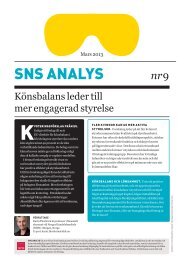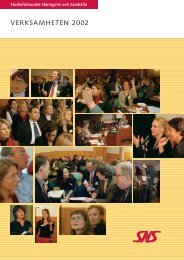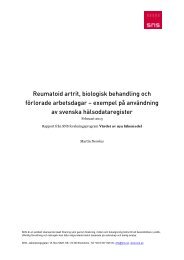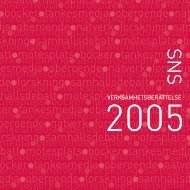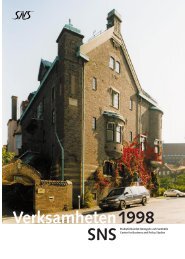Billie Pettersson and Frank R. Lichtenberg - SNS
Billie Pettersson and Frank R. Lichtenberg - SNS
Billie Pettersson and Frank R. Lichtenberg - SNS
Create successful ePaper yourself
Turn your PDF publications into a flip-book with our unique Google optimized e-Paper software.
2. Background2.1. Determinants influencing the use of new medicinesPharmaceuticals represent around 15% of overall health expenditure in the OECDcountries, <strong>and</strong> increasing expenditures have led to the introduction of different policiesaimed at controlling costs <strong>and</strong> improving the efficiency of drug use [4]. These policieshave important implications for the access, rate of uptake <strong>and</strong> use of new medicines.Danzon et al. observed that only 23−27% of products launched between 1995−2005were available in countries (such as Sweden) with pricing <strong>and</strong> reimbursement (P&R)control, compared to 63.8% in the US, where access to the market is generally notrestricted by P&R decisions [5].Use of new medical technology varies widely between countries but also betweendifferent disease areas within a country [6]. The causes for variation in diffusion of newdrugs could be differentiated into three broad groups, macro- or system-leveldeterminants, service organization determinants <strong>and</strong> clinical practice determinants [7].These categories are interrelated. For example, a readiness among clinicians to adoptinnovations in clinical practice is determined, to some degree, by the ease with whichaccess to innovation is provided at the system level. The relative importance of thesefactors will vary depending on the disease area in question <strong>and</strong> the system context.In explaining the potential causes of international variation found in the studymentioned above [6], a number of common themes emerges: (1) health technologyassessment (HTA) processes <strong>and</strong> outcomes can have a significant impact on levels ofusage; (2) service planning, organization <strong>and</strong> direction-setting play an important role inenabling or restricting usage; <strong>and</strong> (3) clinical culture <strong>and</strong> attitudes towards treatmentremain important determinants of levels of acceptance. These themes often work incombination, so, for example, the impact of HTA can either be mitigated or amplifiedby issues relating to service organization or clinical culture, where the main issues arethe availability of or access to specialists.2.2. Pharmaceutical policies in SwedenDuring the past two decades, increasing pharmaceutical expenditures led to theintroduction of a variety of mainly dem<strong>and</strong>-side policies aimed at restricting theescalation [8−10]. These policies were designed to promote the rational <strong>and</strong> costeffectiveuse of drugs at national as well as regional levels. Two of the most importantpolicies were the devolution of the pharmaceutical budget to the county councils in1998 <strong>and</strong> implementation in 2002 of a new system for pricing <strong>and</strong> reimbursement(P&R) according to value-based pricing (VBP). There are indications that the policiesintroduced might have had a restrictive impact on the use of (new) medicines inSweden.The prior P&R scheme was replaced by the current VBP system, where HTA became afoundation for P&R decision-making. HTA has emerged as an important foundation forguiding decision-making <strong>and</strong> allocating resources in health care by TLV, Sweden’sDental <strong>and</strong> Pharmaceutical Benefits Agency for making P&R decisions. VBP meansthat a drug’s value, i.e. cost-effectiveness, is evaluated <strong>and</strong> a price premium over its oneor more pre-defined comparators may be determined <strong>and</strong> used to set the price of that11







